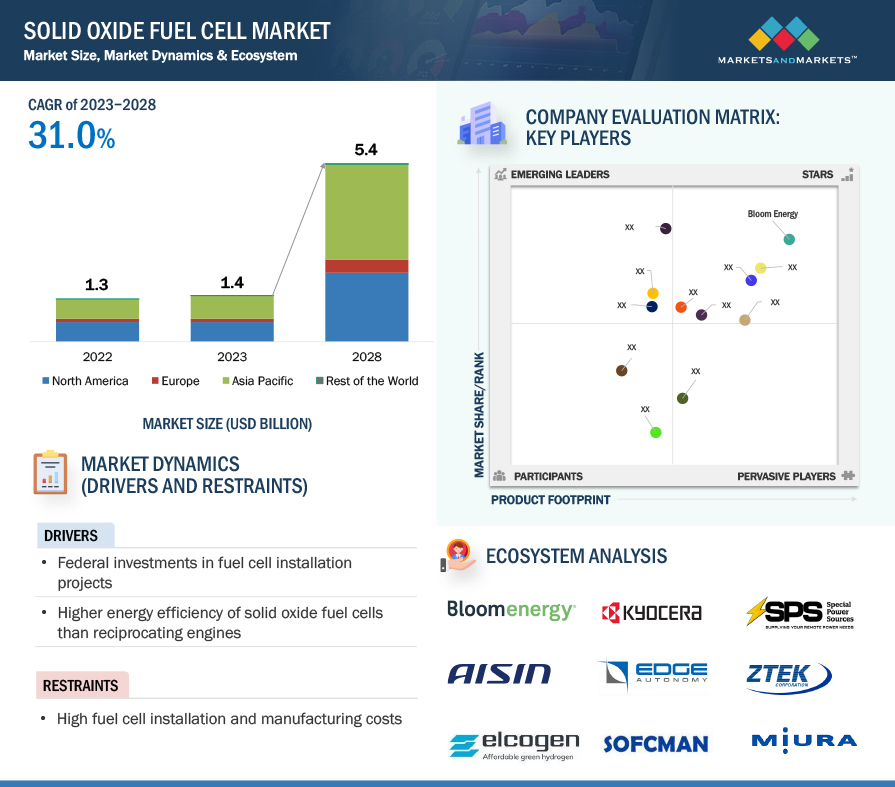According to a research report “Solid Oxide Fuel Cell Market by Type (Planar, Tubular), Component (Stack, BOP), Application (Stationary, Portable, Transport), End User (Commercial & Industrial, Data Centers, Military & Defense, Residential) & Region – Global Trends & Forecasts to 2028″ published by MarketsandMarkets, the solid oxide fuel cell market is projected to reach USD 5.4 billion by 2028 from an estimated USD 1.4 billion in 2023, at a CAGR of 31.0% during the forecast period.
Solid oxide fuel cells are the electrochemical devices that use fuel cell technology to generate electricity. Solid oxide fuel cells are electrochemical devices that convert the chemical energy of a fuel, typically hydrogen, into electrical energy through a chemical reaction. These fuel cells can provide a continuous and reliable source of power for various applications. Growing demand for consumer electronics along with increasing adoption of solid oxide fuel cell (HDI) technology for backup power solutions are expected to drive the demand for solid oxide fuel cell market.
Download PDF Brochure: https://www.marketsandmarkets.com/pdfdownloadNew.asp?id=39365796
The tubular Solid oxide fuel cell segment, by type, is expected to grow at the highest CAGR during the forecast period.
Based on type, the solid oxide fuel cell market has been segmented into planar solid oxide fuel cell and tubular solid oxide fuel cell. The tubular solid oxide fuel cell segment is expected to be the fastest growing segment during the forecast period, owing to even distribution of heat in the system. Tubular SOFCs operate between 900–1,000°C and exhibit higher power densities compared to planar SOFCs. The tubes offer high electrical resistance and are simple to seal. Some tubular designs eliminate the need for seals and allow for thermal expansion.

The stationary, by application, is expected to be the largest segment during the forecast period
This report segments the solid oxide fuel cell market based on application into three segments: stationary, portable and transport. The stationary segment is expected to be the second largest segment during the forecast period. Stationary segment is again categorized into three segments: primary power, backup and combined heat and power. Stationary SOFCs are primarily employed as primary power sources in a variety of facilities, including houses, business buildings, industrial locations, and ports. SOFCs can be installed on-site, even in distant places; on-site installation allows power generation to be matched to the site’s electrical demands. Increasing government investments in stationary applications such as renewable power generation are also propelling the SOFC industry.
Asia Pacific is expected to be the largest region in the solid oxide fuel cell market
Asia Pacific is expected to be the largest solid oxide fuel cell market during the forecast period. The Asia Pacific region, comprising major economies such as China, Japan, and South Korea, are witnessing significant growth for primary power sources owing to increased demand for residential sector. The region has been trying to reduce its carbon footprint from various fossil fuel-powered operations, including power generation. Asia Pacific is one of the leading markets that has adopted green technologies to reduce GHG emissions. Countries such as Japan and South Korea are increasing their investments in SOFC technology.
Ask Sample Pages: https://www.marketsandmarkets.com/requestsampleNew.asp?id=39365796
Some of the major players in the solid oxide fuel cell market are Bloom Energy (US), AISIN CORPORATION (Japan), KYOCERA Corporation (Japan), MITSUBISHI HEAVY INDUSTRIES, LTD. (Japan), and MIURA CO., LTD. (Japan). The major strategies these players adopt include new product launches, contracts, agreements, partnerships, and investments & expansions.


